
DIVING IN THE MOON
HONORING STORY, FACILITATING HEALING
Listening Beneath The Weather:
A Storytelling Strategy For Healing In Haiti
© Laura Simms
This winter in Manhattan, on a day when the snow had all but melted after a storm, I was walking behind a mother and her six year old daughter. We were crossing an avenue, slipping on ice and climbing over an ash colored snow bank. The mother said, “The snow was pretty fun wasn’t it?“ The girl wearing knee high pink snow boots and a pink coat with a hood sprouting straight black hair, responded, “I don’t like the dirty snow!” The mother smiled, “But it was beautiful yesterday.” The girl shrugged her shoulders, no longer looking at her mother, and said, “Whatever!” The possibility of a conversation that was offered by the daughter, ended. What came to mind was a day in the camp in Haiti several years after the earthquake, when I changed how I viewed the power of the Word to heal.
I began working in Haiti in June 2010 for International Medical Corps, six months after the earthquake. Months later, I returned to participate in a narrative and healing project with Mercy Corps. During that time, at the request of a group of adolescent girls living in a small camp behind the walls of a half destroyed school, in unsanitary and insecure conditions – with 145 families in damaged tents – I helped them begin a Group for expression, support and safety. I continued to support and oversee the Girls Group when the project with MC ended.
I am still supporting the girls five years later. They now live dispersed throughout Port au Prince. Their bond is exceptional. The experience that I describe below took place in the spring of 2013. The conversation overheard in Manhattan reminded me that it is not only young women living in displaced camps that are at risk of losing heart and restorative communication.
One afternoon in May 2013, I arrived for my last days of a visit with the girls. They arrived over an hour late. I was looking forward to seeing them. I wanted to talk about, and make stories about, our extraordinary day “out of the camp” when we left the filth and rubble of tents and inadequate outhouses for the first time to go into the countryside. Kenscoff was only nominally affected by the earthquake. The girls danced and shared stories for hours in a large public garden cavorting on green lush grass, with a sense of unabashed joy. They traded jackets, polished their nails, and talked about the future. They were released from the stress of their everyday lives under the tent. All the way back they sang children’s songs and pop tunes. They begged me to stop twice on the road for lunches. I did. It was growing dark when they climbed out of the van yawning and satisfied.
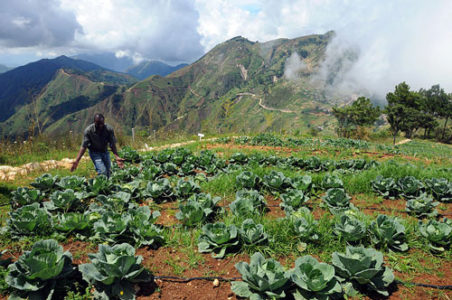
The next day, sitting near a rubble half wall under a single tree on a three legged chair, I waited for the girls to appear. Each girl had taken a long time to wash her hair and dress for our meeting as if they were attending a formal dinner party. When they entered the tent they were sauntering slowly. They sat in strange silence as if we were strangers; perched sideways, arms akimbo, their spines like rubber curving against the chairs. They turned away from each other. They did not make eye contact with me.
Their disinterest disarmed me. It felt impenetrable. I was annoyed. The translator, a young Haitian student, who had accompanied us the day before, whispered to me, “They are depressed.” I asked, “Why?” She explained, “It was hard to return to the camp after a day out.” My annoyance evaporated.
I recognized the not so hidden pain they warded off daily. But I felt empty. Not knowing is often how I find my way into an activity, even if I have a detailed plan. I grew quiet and looked at them without my irritation; softened. I breathed to quiet my mind. Creativity is not something that flowers with strategies and impatience. Getting stuck in my own story would have left me only able to rely on a prepackaged plan that would elicit prepackaged responses. I sought for the insight that arises with authentic response within myself, and from them, when I surrender to the intelligence of not knowing. I rely on the power of being present. They shifted. Their arms unfolded, but they said nothing.
I stood up, “All right. We had a great day. It is really hard to be back isn’t it?” A few of the girls nodded. “So let’s be here!” I said.
I thought of an activity that might bring them back to their senses; to the energy of engagement that is life nourishing. My intention was not that clear at the moment, but in retrospect I realize I needed to invite them to not abandon the depth of their feelings, but also to find a way to harvest what was taking place inside of those feelings; to shake up the stuck energy of their unhappiness and get involved. In whatever was present lay the possibility and the gift.
To do that is to give an experiential instruction: it is fine to feel disappointed, upset, confused sad or angry. They have the right to feel these things, but do not have to lose heart under the weight of the stories they attach to their unhappiness that sticks like glue and renders them numb. Creativity, curiosity, joy of seeing something outside oneself, is the key that unlocks the possibility nesting inside of their feelings. I remembered an exercise I had explored with youth in a violence prevention project in Mississippi:
“I would like you to go outside of the tent. You can keep any mood you want. Walk alone. But go out and see. Then see again. Find something you hate in the camp. Look at it. Then look at it again. Then look from another direction. Look again. Write about it. Describe it. Make of list of colors, shapes, smells, thoughts, images. Write what you hate. And then come back.” They stood, a bit reluctant, but the word “hate” generated some interest so they walked out. They returned in ten seconds. “Go! Go out! Really walk around until you find something. Don’t talk to anyone. Just go somewhere. Look at one thing that you hate! Then describe it.” I pulled new colorful journals that I was going to give them later that afternoon. “Here is a fresh notebook and a pen. Write. Write. I don’t care what you say. Just write what you feel. And, a description of what you see that you hate.”
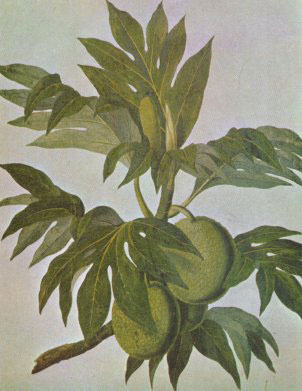
They each took a notebook and a pen. They loved getting new journals. They went out for the second time with more intention. Somehow they were curious. Their footsteps were more lively. One girl stopped by a water hole surrounded by trash. Another girl sat in front of a filthy wood door leaning against a tarp. Another girl stared at a tree growing against a cracked well. I called out, “Look and then look again. Then look again. What do you dislike?”
Two girls were standing beside a broken car, rusted and without wheels. They circumambulated the burned vehicle, covered with graffiti and leaning against each other began to fill empty pages. Ten minutes later they returned. Each one had her notebook in hand. They sat down and stared at me. I said, “You have four minutes. Write a poem called I HATE.”
They began to write. The silence was rich, transformed. They wrote without stopping. Then each girl read what she had written. Every single poem or tale was alive with feeling and description.
“I hate the breadfruit tree. I hate the wall it grows on. I hate the taste of Breadfruit. Everyone likes it. But I hate it. It is bitter, bitter on my tongue. It is ugly. I hate breadfruit.”
Each girl had a poem, an incantation, breathing alive with image and vividness.
“The trash is illness. The water that flows from the toilets is cholera. People walk with their heads down. Paper and plastic and leaves. I hate the dirt.”
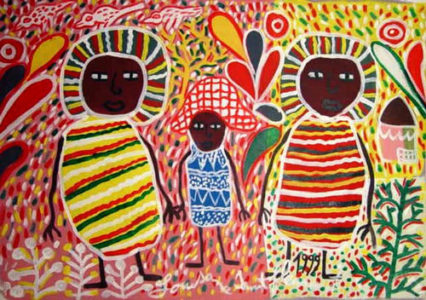
What mattered most to me was that they had come alive. They were responding to seeing and to the life force within themselves. The energy that stuck them in unspoken sorrow burst open like a fruit spilling out words that held their feelings. They were listening, safely, to one another, appreciating the force of each other’s lines. A horror of images about trash and dangerous boys, cholera, depression, dirt, hunger and fear rolled off their tongues from the page. Their words however were potent. They became cheerful. As they read, being heard, their complaints became songs. Our circle was vibrating with interest. They were participating in the energy of renewal and faith. Like women sharing through the ages, the words gave them strength “to bear the world they lived in.” It was an act of survival, and living. They partook of outrageous dependence on what could not be destroyed – their creativity, their embodied sense of presence and participation with each other.
Without stopping to say anything about what they had written I sent them out again.
“Now go again! Find something you LOVE; something you appreciate or treasure in the camp. It can be a surprise or something you see every day. It can be a person. Look at it or someone from every direction. Describe it in your notebook in as much detail as you can.” Off they went. This time looking, and writing without hesitation.
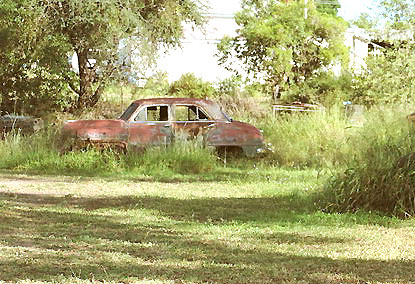
For the What I Love lists, one girl had sat in a classroom where there were rows of clean chairs. Another had stopped in front of her mother who was sitting on a piece of plastic in the dust between tents. The daughter walked around her mother, observing, and making notes. The mother, moments before head bent toward the ground, looked up smiling and began to preen and flirt with her daughter. Others took their time finding something they admired. I noticed three girls standing before the same rusted car of another’s “I hate” poem. The youngest girl, who lived in a small tent with nine family members, sat on the ground with a tea cup. After twelve minutes, I called them back. They rushed to their seats; without instruction, they began to write. Then, read out loud and listened to each other.
They broke through disappointment. The rhythm of their words and their thoughts, the beauty of expression lifted them from despair. The poems were some of the best they had shared. My translator repeated each one two times. She read them in Creole with all the emphasis of great recitation. The girls repeated their lines in unison with her making a chorus. Allowed to give form and image to complex feelings made what might have been a source of misery, into a flowering of personal and communal empowerment. What they loved was so easily forgotten that remembering and honoring small things and each other was breathtaking. They had written with potency and true poetry.
Then we made time for poetry story repair. With a partner, they reread their poems to help each other make corrections or make changes, or just approve what was spoken. We had often talked about how long it takes for a great poem or a good story to be born. This reparative element deepened their capacity for listening. It brought them more fully into being present for themselves and each other with respect. Our “go around” that always followed a poetry session or a storytelling activity, was filled with compliments for each other.
Then we talked about the day before. They loved the trip. The conversation was lively. Even the statements of how hard it was to return were authentic but not sabotaging. The girls teased each other about singing and playing in the gardens. Mind released from the binding force of habitual sadness opened into new strength to speak about their lives. The exercise of exploring the extremes of what was hated, and what was loved, stretched the muscles of acceptance, intelligence, and resilience. What we had done was an inner mind poetry yoga where the imagination gave us access to transformation, detail, alternative and bigger views, and knowing a place within that was untouched by the contingencies of what was all around them. On another afternoon, a year later, building on this experience, I sent them out again to see with the emphasis on making metaphors; freeing their minds even more to find beauty and solace and power within themselves. “I love writing,” they said boldly, often.
Ending a session was joyful, poignant, and ceremonial. We became choreographers of stories to make dances. Someone chose music on the ipod that still worked. Someone else called out a situation or an image or a character. Starting on the ground they danced becoming trees growing. They giggled like children and gyrated like teenagers.
Then we ate. The girls always ate in silence. And they always pushed half of the food to one side of the container to take back to their families.
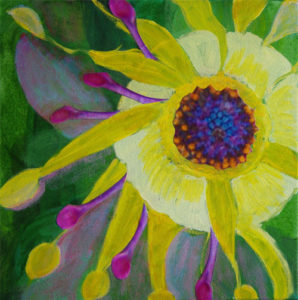
We closed with wishes for each other – standing shoulder to shoulder, passing our praises and blessings, in a garland of kindness. To draw up from within what is naturally good and generous is to feel the place within ever resourceful and never damaged or limited. Then they followed me to the car.
The reality of the girls lives has been filled with demands, loss and suffering. Being together in a creative way has rendered them not Isolated; or hopeless.
When there is an emergency or need in the circle, we give it time. We often broke into two small groups so whoever needs extra time to be heard can share their problem, agony, dilemma, confusion about love, in confidence and privacy. Sometimes they ask for suggestions. Sometimes for different points of view. We all listen deeply to each other’s stories. In this way, hearts are uplifted. Problems that feel beyond hope find solutions, alternative viewpoints or at least support and empathy. Listening and sharing poems and stories, we lean into the long heritage of oral tradition. They unite with a past where their grandparents sat on porches in the provinces or at ceremonies sharing folktales and old stories. Some stories they knew stretched back to Africa across continents and time. We included the present, filled with the aftermath of disaster and the loss of their homes with respect. We also included the capacity they had to make something of meaning and beauty in the midst of difficulty. These two threads gave them strength to advocate for their safety and futures. Things that could not be changed were less dire when shared.
This is what I thought about while overhearing the snow street conversation between a mother and her daughter in Manhattan. I wondered what would have occurred if the mother could have said, “What do you hate about the dirt?” And listened to her daughter. Or, asked, “What do you like about clean snow?” Would they have joined together, like the girls in the camp, whose sharing has brought them the visceral knowledge of resilience – and the uncovering of joy regardless of circumstance; found in their misery like a buried treasure? Women and girls living in almost every situation, but particularly in displaced persons camps or in conflict zones, live in danger of losing their sense of dignity and hope.
The arts may not provide immediate solutions for changing their environment, or culture, but it accesses and supports the courage and ability to make change and to live without drowning in despair. The commitment to being present, to seeing, to giving voice to image and emotion, reaches into what is innate, healing and empowering. The flowering is inner creativity, strength of spirit and heart; lessening of stress and isolation; and a restoration of beauty. The power of making a poem, a story or a dance lifts them, us, out of the tyranny of our own minds that either fixes us in a difficult place or encourages us to imagine ceaseless opportunity now and in the future.
At present, in Haiti and throughout our world, the plight of young women displaced and demeaned is overwhelming. It is my hope that we include in all of the priorities for relieving suffering, the empowerment from within of each young woman so she has the strength to restore dignity, and access that place within that can never be harmed. The arts are not entertainment, but the very path of liberation and treasure house of transformation. To begin to tell our stories and hear one another, we have to access this place of being present with trust and listening, and seeing and expression. It may be the source of a profound healing revolution.
 Haitian sculpture cut from metal oil drum, photo by Tubamirum
Haitian sculpture cut from metal oil drum, photo by Tubamirum
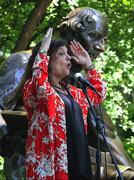 Laura Simms has been a poet, storyteller, coach and humanitariian for over 45 years. She is presently the artistic director of the iconic Andersen Storytelling Statue project in NYC and performs, teaches and speaks worldwide. Her commitment is to compassion and healing through engaged narrative. Her most recent book is OUR SECRET TERRITORY: The Essence of Storytelling (Sentient Books). Jay O’Callahan called it, “The best book about storytelling ever written.”
Laura Simms has been a poet, storyteller, coach and humanitariian for over 45 years. She is presently the artistic director of the iconic Andersen Storytelling Statue project in NYC and performs, teaches and speaks worldwide. Her commitment is to compassion and healing through engaged narrative. Her most recent book is OUR SECRET TERRITORY: The Essence of Storytelling (Sentient Books). Jay O’Callahan called it, “The best book about storytelling ever written.”
